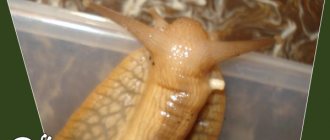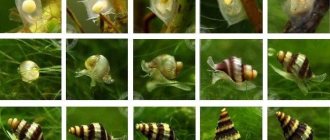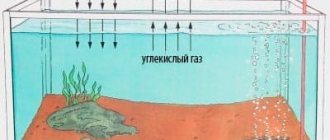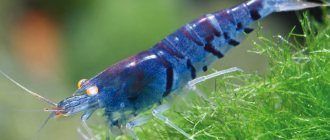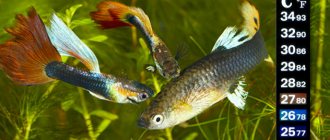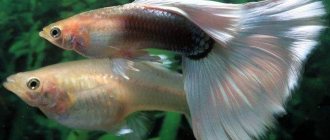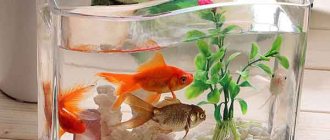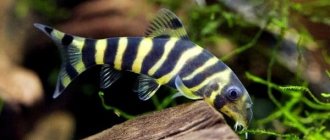It is difficult to imagine a modern aquarium where, along with fish, snails would not live. Especially considering that there is now such a variety of species and forms of these mollusks!
Freshwater zebra snail Nerritina
What fish can you keep snails with? With all the non-predatory and non-feeding snails! They go well with both small (neons, rasboras, zebrafish, tetras) and large fish (discus, angelfish), as well as shrimp and crayfish. But what do snails bring - benefit or harm, and are they needed in the aquarium?
Everything is good in moderation. This rule also works for snails in a home pond. Of course, there are both pros and cons to this issue. Let's take a closer look at them.
Freshwater horned striped snail (beeline) Clithon diadema
Benefits of snails in an aquarium
- snails pick up leftover food from the bottom and from hard-to-reach places, acting as cleaners;/li>
- snails eat rotting parts of plants;
- snails loosen the soil, preventing it from caking;
- snails eat unnecessary algal fouling;
- snails can serve as an indicator of the chemical composition of water (for example, when oxygen in the water decreases, they rise to the surface);
- snails give a home aquarium a more natural look;
- Some types of snails are so attractive in appearance that they will serve as a real decoration!
In addition, for some species of fish, such as loaches and macropods, small snails serve as an additional source of food, and owners of tetradons keep snails to grind down the constantly growing teeth of these fish.
Snail - acrolux
A small aquarium snail, acrolux, in adulthood has a size of no more than 2 mm. Its shell is often compared to a transparent cap that covers the body of the mollusk.
Acroluxes, even when in small numbers, are able to maintain cleanliness in the aquarium by absorbing the remains of fish food, dead parts of plants and other organic matter.
By request: small snails photos, the search engine will provide images of acroluxes. But one should not look for similarities in them with most representatives of aquatic mollusks. This species of snail leads a closed and rather hidden lifestyle. They appear on the walls of the aquarium only at night, and during the day they hide in algae thickets or in the ground. Therefore, in order to have accurate information about the number of these snails in your aquarium, you need to turn on the light in the middle of the night in the room where it is located.
The overpopulation of a home reservoir with these mollusks indicates its increased pollution. To prevent their presence from being so intrusive, care should be taken to reduce the nutritional norm for the remaining inhabitants of the aquarium. And since the very small acrolux snails do not live in clean water, they will disappear on their own.
But along with the benefits, snails also cause harm:
- uncontrolled proliferation of melania leads to a sloppy appearance of the aquarium;
- some species (maryse) eat at the root of the plant;
- snails eat fish eggs;
- a large number of snails can also lead to water pollution;
- In rare cases, it happens that snails get into filters and pumps, which leads to the rotor stopping.
Each aquarium owner can know in advance how certain representatives of these mollusks will behave, having previously studied their development and nutritional characteristics. For example, neritin eggs are not able to develop in fresh water. Thus, when keeping zebra snails, red-spotted snails and others from this family, the aquarist can be calm, no offspring will appear! If you get large snails, such as marise, ampullaria, you should feed them with plant components: lettuce, zucchini, cucumbers, cabbage. This will reduce their interest in the plants in the aquarium. The number of snails is also affected by the amount of food leftovers: the more food left from the fish, the greater the food supply of the snails.
Snail breeding
Gastropods in most cases are oviparous animals. The process of fertilization and egg laying depends on the snail’s habitat.
Snails with lungs, living in fresh waters and on land, are hermaphrodites. Such mollusks have both female and male sexual characteristics. In this connection, during mating, cross-fertilization occurs.
Freshwater snails lay eggs in capsules, and land snails lay eggs in dug holes. The mollusk can lay up to 85 pieces at a time. Eggs mature within 28 days and can have different colors:
- transparent;
- green;
- white;
- pink.
The development of this snail takes place without stages of transformation. Having passed the required period of maturation, a fully formed individual with a transparent shell is born, which hardens over time and acquires its own color.
Snails with gills are heterosexual creatures. Males are endowed with a testis and a vas deferens. Female mollusks have an ovary and an oviduct.
Eggs are laid in a special cocoon with a lid, which dissolves as the larvae develop. For the safety of future offspring, the outer row of eggs is not filled, this allows the predator to be left without lunch.
The development of gastropods occurs with transformations from an egg into a larva (veliger). With the help of outgrowths with thin cilia, it moves and feeds on small particles of food of plant and protein origin. After a few days, the mollusk forms and sinks to the bottom.
There are unique species of gill snails that do not lay eggs but go through a gestation cycle. The embryo remains in the mother's body until it is fully mature and only then is it born.
Reviews of freshwater snails
Dergacheva, review of nerritin red-spotted
They often crawl above the water's edge and especially love to bask on a pebble under a lamp. The only depressing thing is their attempts to reproduce. single dots (like mini-seed seeds of pink and then red color) are very difficult to wash off stones even with a brush, and they do not disappear over time. and also - they live a long time. With my American cichlids, not a single snail survives, even the marise is not sweet, but these ones live and delight.
Natalia, review of nerritina red dot
A really beautiful snail, large, with a funny striped body. No shortcomings have been noted yet. I’ve seen on forums that they should stain everything with white caviar... I don’t have anything like that at all. I bought Neritinka in February, since then she has been crawling, living, not offending anyone and not being offended herself. The only thing that scares me is that I have soft water! So far I haven’t noticed any dissatisfaction on the part of the snail and its shell... but we need to keep watching.
Inna Nesterkina, review of melania vulgaris
Very good snails, but they should be plumper than in the photo. They turn up the soil well... And they also show whether everything in the aquarium is in order; if suddenly everything climbs up, it means there is a sharp lack of oxygen. And they love to travel... and they don’t just sit in the ground.
Ampullaria sp. Pink
All freshwater snails
Chinese snail
From the reports of international researchers in 2013, it is clear that in Southern China (Guangxi Province) empty mollusk shells were discovered, the size of which did not exceed 1 mm. Soil sampling for analysis was carried out in the area of limestone rocks.
As a result of studying the samples obtained, scientists came to the conclusion that they were dealing with new, previously unknown species of microscopic snails. Unfortunately, the shells were empty and a DNA sample could not be isolated
Scientist Barna Pall – Gergely, an employee of Sinsu University, decided to name the micromollusk discovered in the singular after his wife. A scientific work was devoted to the snail Angustopila dominikae. Poll was one of the authors of this work. To imagine the size of this creature (0.86 mm), you need to understand that it can fit in the eye of a needle.
The microscopic Chinese lung snail A. domenikae has a light gray shell with an oblong entrance. As it was found out, it belongs to the genus of giant African land mollusks, but their size is reduced by 9 million (!) times.
Another species of small mollusk discovered in China is Angustopila subelevata. Its parameters are slightly higher than domenikae and range from 0.83 to 0.91 mm.
Since living specimens of these mollusks could not be found, scientists concluded that they dried out as a result of climate warming.
Types of aquarium snails
We list several harmless and even useful species of snails suitable for aquarium keeping.
Ampullaria
Description. Apple snails are the most common harmless mollusks, the shell of which can reach 7 cm in diameter. The shell is usually yellow. Dark striped apple snails are less common.
Reproduction. Unlike their counterparts, apple snails are bisexual, so for their reproduction you will need at least three individuals.
Conditions of detention. Yellow snails in an aquarium are unpretentious to living conditions and do not require special care. The following conditions will be sufficient for them:
- the water temperature should be from 18 to 27 degrees;
- a filter for the pond is necessary;
- apple snails feed on soft foods such as boiled vegetables and bread;
- You can’t house apple snails with predatory fish;
- there must be enough calcium in the water to keep the shell strong;
- Apple snails are often placed in aquariums overgrown with algae, since mollusks love to feed on them.
Fiza
Description. Physes are brown or yellow-brown snails with a pointed shell that breathe with lungs and are able to clean the walls of the aquarium from plaque. These snails can reach the most difficult to reach places and clean them.
Reproduction. Physae lay eggs on plant leaves. One clutch can contain more than 20 eggs, so reproduction occurs at a fairly rapid pace. However, fish and other inhabitants of the aquarium love to feast on eggs, and there is no need to worry about the rapid reproduction of eggs.
Conditions of detention. Physicals must be kept in the following conditions:
- the water temperature must be at least 20 degrees;
- required water hardness 8–18 dH;
- Soft water is not suitable for physical exercise; its shell begins to collapse.
Neritines
Description. Neritines are small tropical snails measuring about 2.5 cm in diameter. The colors are varied: from olive to almost black. There are also stripes of golden, black and other colors.
Reproduction. Neritines can only reproduce in salt water. In freshwater they also lay eggs, but mollusks do not hatch from them.
Conditions of detention. Since neritines are tropical creatures, they require special conditions:
- the capacity of the aquarium must be at least 40 liters;
- water temperature - at least 24 degrees;
- hardness should be medium or high;
- the water must be changed frequently so that ammonia does not accumulate in it;
- required acidity 7.5.
Melania
Description. Melanias have a color similar to the color of the soil, so they are difficult to notice. Their shell is gray-green with small inclusions. The melania's hard shell protects it from predators. Melanias are extremely healthy mollusks. By cleaning the soil and mixing it, these snails greatly benefit the aquarium ecosystem.
Reproduction. Melanias multiply quite quickly, populating the entire space around them. Therefore, it is better to keep this process under control.
Conditions of detention. These snails are extremely unpretentious to their living conditions. The only important condition is temperature; other parameters are not so important for them:
- optimal water temperature is from 18 to 28 degrees;
- Any food is suitable for melania; they can feed on leftover food from other fish or algae.
Coil
Description. The coil can often be found in modern aquariums. These snails in natural conditions can reach up to 3 cm in diameter, but in an aquarium they will not grow larger than 2 cm. These molluscs have a protrusion of the mantle that serves as gills. The coils are designed in such a way that they quickly deplete oxygen reserves. This is quite dangerous for their lives.
Reproduction. Coils are hermaphrodites and are therefore capable of self-fertilization. They reproduce quite quickly, and to reduce their birth rate, it is necessary to reduce the amount of algae from the aquarium and the fish food.
Conditions of detention. The coils do not require special care, the main thing is that the aquarium is equipped with an aerator: it is necessary to replenish oxygen supplies. And we should not forget about control over the reproduction of mollusks, otherwise they will fill the entire aquarium.
Snails
Tylomelania
Description. Tilomelania are real giants among their fellows. The size of their shell can reach 12 cm. The colors are very diverse: black, yellow, white, speckled. These large mollusks can have spines or a completely smooth shell.
Reproduction. Tylomelanias vary in gender and are also viviparous mollusks.
Conditions of detention. Tilomelanias are quite demanding to care for. Their content requires compliance with the following points:
- Telomelania cannot be housed together with other types of snails;
- hard water is not suitable for keeping;
- the acidity of the water should be high;
- large individuals settle in containers at least 80 cm in height;
- tilomelania need feeding 2-3 times a day, they are very voracious, but omnivorous;
- these mollusks need shelter and do not tolerate bright light;
- They require a lot of free space, so you should not plant the aquarium with a lot of algae.
Helena
Description . Helena is a snail that eats its own kind. If there are too many shellfish in the aquarium, you can add Helena there . If there is no live food, it feeds on organic debris or fish food. Helenas are quite small, reaching only 2 cm in shell diameter. Their conical shell is yellow in color and has a spiral brown stripe.
Conditions of detention . Helena does not need special conditions, but it is worth considering that she prefers to eat live mollusks. The soil for Helena should be soft so that it is easy for her to burrow into it.
Marisa
Description . Another giant among snails is the marise. Its shell can reach almost 6 cm in diameter. The shell is gray or light brown, with a black spiral stripe. Maryse prefer to feed on plants, often eating them at the root. If you need to thin out the vegetation, feel free to start a mariz.
Reproduction . To breed marise, you will need two individuals: male and female. They lay eggs on the walls of the aquarium or on plants. The eggs are a jelly-like mass with small snails inside.
Conditions of detention . Maryzas are quite demanding and need the following conditions:
- water should be of moderate hardness pH 7.5–7.8;
- water temperature from 21 to 25 degrees;
- the aquarium must be covered so that the mollusks do not get out of it;
- however, you need to leave a small gap, since marises breathe atmospheric air;
- Maryse can live in salt water, but cannot reproduce.
